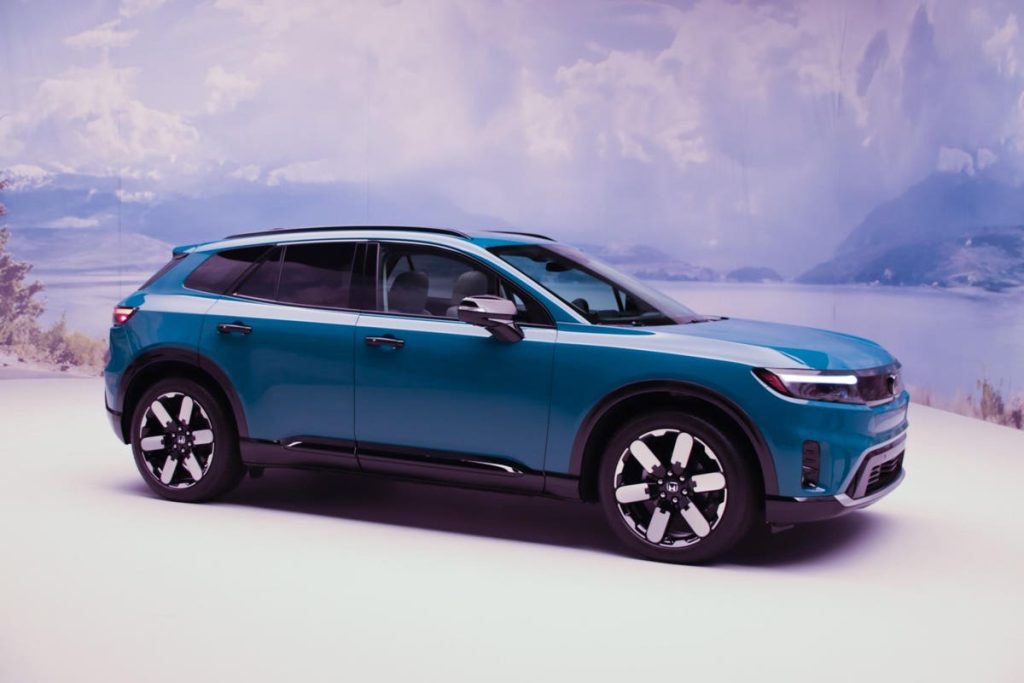Over the past 25 years, Honda has periodically dabbled in various forms of electric vehicles including both battery electric and fuel cell models. But none of them have ever sold/leased in any significant volumes in North America. Even the Honda e sold in Europe and Japan has barely topped 4,000 units a year. But all of that is about to change thanks to a partnership with General Motors that will bring us the Acura ZDX and the new Honda Prologue which we have seen for the first time.
Like the ZDX, the Prologue is being produced for Honda by GM on its Ultium electric architecture. The top hat of both vehicles was done by Honda/Acura designers and engineers within the constraints of the hard points of the GM platform. But there are some pretty substantial differences between these two similarly sized electric crossovers beyond the styling.
Mechanically, the ZDX is virtually identical to the Cadillac Lyriq with the same combination of rear or all wheel drive power and a 102-kWh battery pack. That 12-module pack is essentially one of the two layers found in the 24-module pack of the Hummer EV. A bit of simple math puts the capacity of each module at 8.5-kWh, a number we’ll return to in a bit.
The Prologue is a bit of a different beast that doesn’t correspond directly to any of the known GM Ultium EVs. The platform actually seems to be a bit of a hybrid of components between the Equinox and Blazer EVs. The Honda will be offered in 3 trims, EX, Touring and Elite with the first two having a single motor driving the front axle while the Elite gets a dual motor setup with 288-hp and 333 lb-ft of torque. That’s considerably less performance than the ZDX as well as what is promised from the Blazer.
When the Blazer was initially announced a year ago, Chevrolet promised variants with front, rear or all-wheel-drive. However, they have since dropped the front-drive variant. When asked why Honda was going with front wheel drive as the standard configuration rather than rear drive, chief engineer John Wong explained that Honda wanted to provide a similar driving feel to its mainstream customers who have always had front-wheel drive. For those that don’t opt for the all-wheel drive version, this should make for some easier driving in poor weather conditions.
Chevrolet hasn’t yet released a full set of specifications for the Blazer, but Honda has told us that the Prologue has a 121.8-inch wheelbase, exactly the same number as the ZDX, Lyriq and presumably the Blazer. The Prologue is 192-inches long putting in between the Passport at 189.1-inches long and the 197.7-inch long ZDX. Thus the Prologue will probably be somewhere in between. At 64.7 inches tall, the Prologue is about 0.5-inch lower than the 2WD CRV.
From a design standpoint, the Prologue is considerably more conservative than the ZDX or Blazer. The overall look and feel will be very familiar to anyone that has seen the latest generation of Honda crossovers like the CR-V and HR-V. While there is nothing groundbreaking here, it is nicely executed in the way we have come to expect from Honda. Aside from the solid black panel between the headlights and small, lower grille, the most notable differences from the CR-V is the much shorter front overhang and the new Honda badge on the tailgate. Rather than the traditional H badge, the word Honda is spelled out in blocky letters.
Like the ZDX and the GM EVs, the roofline is relatively low which combines with the long wheelbase to give the Prologue a sportier, more wagon-like profile compared to the more upright Passport. Even in AWD form, this isn’t going to be an off-roader.
Inside, the Prologue has a fairly contemporary Honda look compared to the more zoomy looking interior of the Blazer. There is an 11-inch digital cluster display in front of the driver and a 11.3-inch center touchscreen mounted tablet style and discreet from the cluster. Like other Hondas, the Prologue retains physical knobs and buttons for climate control and a volume knob.
The infotainment system is the same Android Automotive system that debuted on the Accord with Google automotive services built in, including Maps, Assistant and the Play store. Unlike GM, Honda is keeping support for Apple Carplay for those that prefer to connect their phone. Thanks to the long wheelbase, the rear seat is particularly spacious as well.
Another area where Honda has taken a bit of cross between the Equinox and Blazer is charging. For AC charging, the Prologue will support up to 11.5-kW which can easily provide a full charge when plugged in overnight. However, at DC chargers, Honda is using the 150-kW capability from the Equinox rather than the faster 190-kW from the Blazer. Given the smaller battery than the ZDX, this shouldn’t make a noticeable difference on road trips.
Honda says the FWD Prologue should be able to go over 300 miles on a charge. The heavier Prologue Elite AWD with 21-inch wheels will not go as far, but it will probably have a range of about 260-270 miles.
Like the ZDX, Honda plans to give Prologue buyers a choice of three charging packages. The first is a 7.6-kW charging cable with interchangeable tips to plug into either a standard 120V outlet or a 240V NEMA 14-50 outlet. This comes with a $250 credit toward installation of an outlet and a package of $300 in public charging credits. The second is an 11.5-kW 240V wallbox charger with $500 installation credit and $100 of public charging. The third for those that either already have chargers or aren’t able to install home charging is $750 worth of public charging credits.
Honda isn’t yet supporting Plug&Charge, but the HondaLink app for the Prologue will allow drivers to link their ElectrifyAmerica and EVGo accounts and provide a single interface to trigger and pay for DC charging sessions. At launch, the Prologue will still have a CCS charging connector, but adapters to charge at Tesla Superchargers will be available sometime in 2024 and in 2025, it will transition to the Tesla-designed NACS connector.
Full pricing will be announced closer to the launch in the first quarter of 2024, but Honda says it will start in the upper $40K range. However, since the Prologue is built in North America with US made batteries it will be eligible for the $7,500 federal tax credit along with whatever state and local incentives might be available. Unlike the previous zero emission vehicles offered by Honda, the Prologue will be available in significant volumes with about 45,000 in the first year and about 70,000 when fully ramped up. Initial sales will start in California and other states that follow its zero-emission-vehicle requirements and then expand to all states within a few months.
Read the full article here








